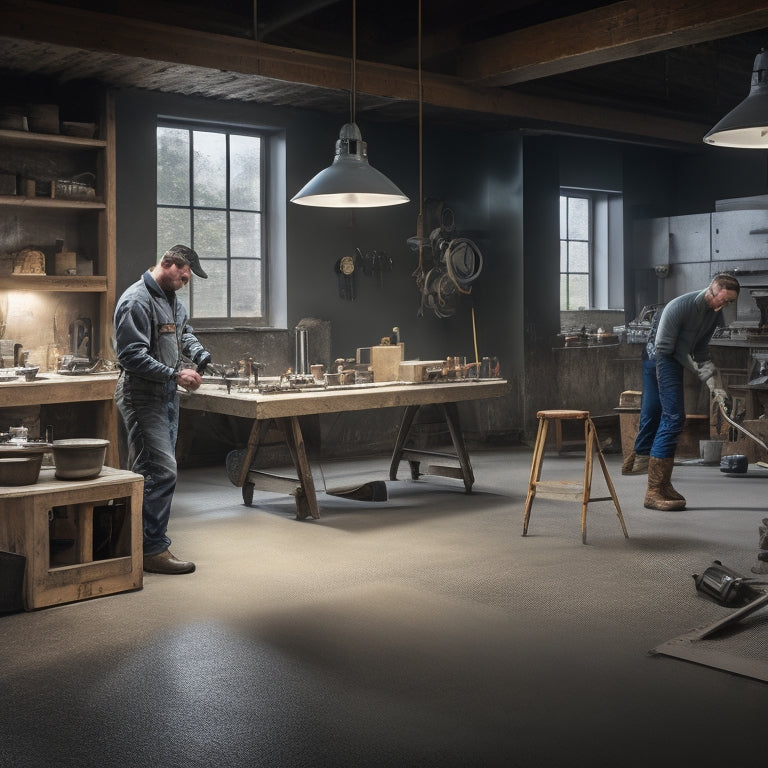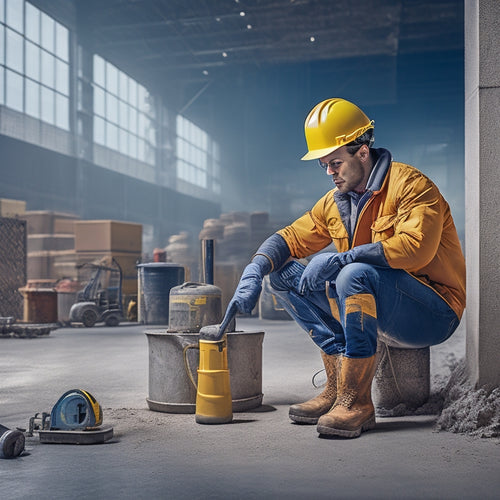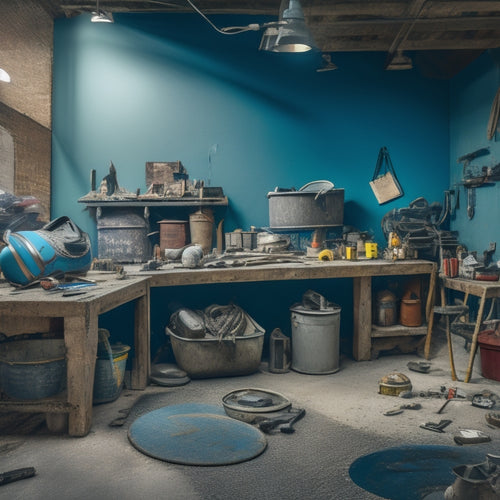
3 Best Concrete Flooring Tools for a Flawless Finish
Share
To achieve a flawless finish on your concrete flooring project, you'll need three essential tools in your arsenal. First, a reliable hammer breaks down aggregate for best consistency in the concrete mix. Next, a sturdy trowel applies and spreads the mix evenly, smoothing out imperfections. Finally, a precision leveling tool guarantees a perfectly level surface using advanced techniques. With these tools, you'll be well on your way to a professional-grade outcome; but to truly reveal the full potential of your concrete floor, you'll want to investigate the essential subfloor preparation tools and finishing techniques that can take your project to the next level.
Key Takeaways
- A reliable hammer is essential for breaking down aggregate to achieve optimal consistency in the concrete mix for a flawless finish.
- A sturdy trowel is necessary for applying and spreading the concrete mix evenly, smoothing out imperfections and ensuring a level surface.
- A precision leveling tool ensures a perfectly level surface, which is critical for a professional-grade outcome and aesthetically pleasing concrete floors.
- Proper subfloor preparation tools, such as a subfloor leveling tool and moisture meter, are crucial for identifying and correcting inconsistencies that can affect the finish.
- Specialized equipment, like planetary grinders or floor polishers, and polishing compounds and abrasives are vital for achieving a high-gloss finish on concrete surfaces.
Top Concrete Flooring Essentials
Three fundamental tools form the foundation of a well-stocked concrete flooring toolkit: a reliable hammer, a sturdy trowel, and a precision leveling tool.
You'll use these essentials to guarantee a flawless finish, from mixing and applying the concrete mix to achieving a perfectly level surface.
When mixing your concrete, a reliable hammer helps you break down aggregate and achieve the right consistency.
A sturdy trowel is then used to apply the mix, spreading it evenly and smoothing out any imperfections.
Finally, a precision leveling tool comes into play, allowing you to fine-tune your surface using advanced leveling techniques.
These techniques, such as the "screed and float" method, assure a surface that's both level and smooth.
With these tools in your arsenal, you'll be well on your way to creating a professional-grade concrete floor that's both durable and aesthetically pleasing.
Must-Have Subfloor Preparation Tools
Before you start applying concrete, you need to make sure the subfloor is properly prepared. A well-prepared subfloor is vital for a flawless finish, and the right tools can make all the difference.
To ascertain a level surface, you'll need a subfloor leveling tool, such as a self-leveling screed or a laser level. These tools help you identify and correct any inconsistencies in the subfloor, providing a solid foundation for your concrete flooring.
Moisture testing is another important step in subfloor preparation. Excessive moisture can cause concrete to deteriorate or delaminate, so it's important to test the subfloor for moisture levels. A moisture meter or a calcium chloride test kit can help you determine if the subfloor is dry enough for concrete application.
Additionally, you'll need a scraper or a grinder to remove any old adhesives, paint, or other substances that might interfere with the concrete's bond to the subfloor.
With these must-have subfloor preparation tools, you'll be able to create a strong, durable, and visually appealing concrete floor that meets your expectations.
Finishing Touches for Perfection
With your subfloor properly prepared, you're ready to apply the final touches to achieve a flawless concrete floor.
Now it's time to focus on polishing techniques and surface treatments that will raise your concrete floor to new heights.
You'll want to employ a series of progressively finer polishing techniques to refine the surface, eliminating any imperfections and achieving a high-gloss finish.
This may involve using specialized equipment, such as planetary grinders or floor polishers, in conjunction with polishing compounds and abrasives.
In addition to polishing, you may also consider applying surface treatments to enhance the appearance and durability of your concrete floor.
This could include applying a sealant to protect the surface from stains and wear, or using a dye or stain to add color and visual interest.
Frequently Asked Questions
Can I Use Concrete Flooring Tools for Other Types of Flooring?
You can adapt concrete flooring tools for alternative flooring types, but it's crucial to research cross-application techniques, ensuring a seamless shift and best results, rather than risking subpar performance or damage to your new flooring.
How Often Should I Clean and Maintain My Concrete Flooring Tools?
After a grueling 10-day flooring project, contractor Sarah extended her tool lifespan by 30% with daily cleaning and weekly deep cleaning, proving that regular maintenance enhances tool longevity and optimizes cleaning frequency.
Are Concrete Flooring Tools Suitable for DIY Projects or Professionals Only?
When tackling concrete flooring projects, you'll find that while DIY enthusiasts can use these tools, they often require professional knowledge to achieve ideal results, so it's crucial to assess your skills and decide whether to DIY or hire a pro.
Can I Rent Concrete Flooring Tools Instead of Buying Them?
You can definitely rent concrete flooring tools, which is a cost-effective option, especially for one-time or small projects, offering rental advantages like reduced upfront investment and access to specialized equipment without long-term commitment.
What Safety Precautions Should I Take When Using Concrete Flooring Tools?
You're 3.5 times more likely to get injured on a construction site without proper training, so prioritize safety! Wear personal protective equipment, like gloves and goggles, and perfect tool handling techniques to minimize risks when operating concrete flooring tools.
Conclusion
You've got the perfect concrete flooring tools in your arsenal, and now it's time to put them to work. With these essentials, your subfloor is a blank canvas, ready for you to create a magnum opus. Just as a painter needs the right brushes, you need the right tools to bring your concrete flooring vision to life. With these top picks, your finish will be as smooth as silk, and your customers will be walking on air.
Related Posts
-

10 Best Tools for Sealed Concrete Flooring on Budget
When starting on a sealed concrete flooring project on a budget, you'll need to prioritize essential tools without sa...
-

What Tools Do You Need for Concrete Flooring
You'll need a thorough arsenal of specialized tools to achieve a high-quality, professional-looking concrete floor, i...
-

Free Design Tools for Concrete House Planning
You can kick-start your concrete house planning project without breaking the bank, as there are several free design t...


